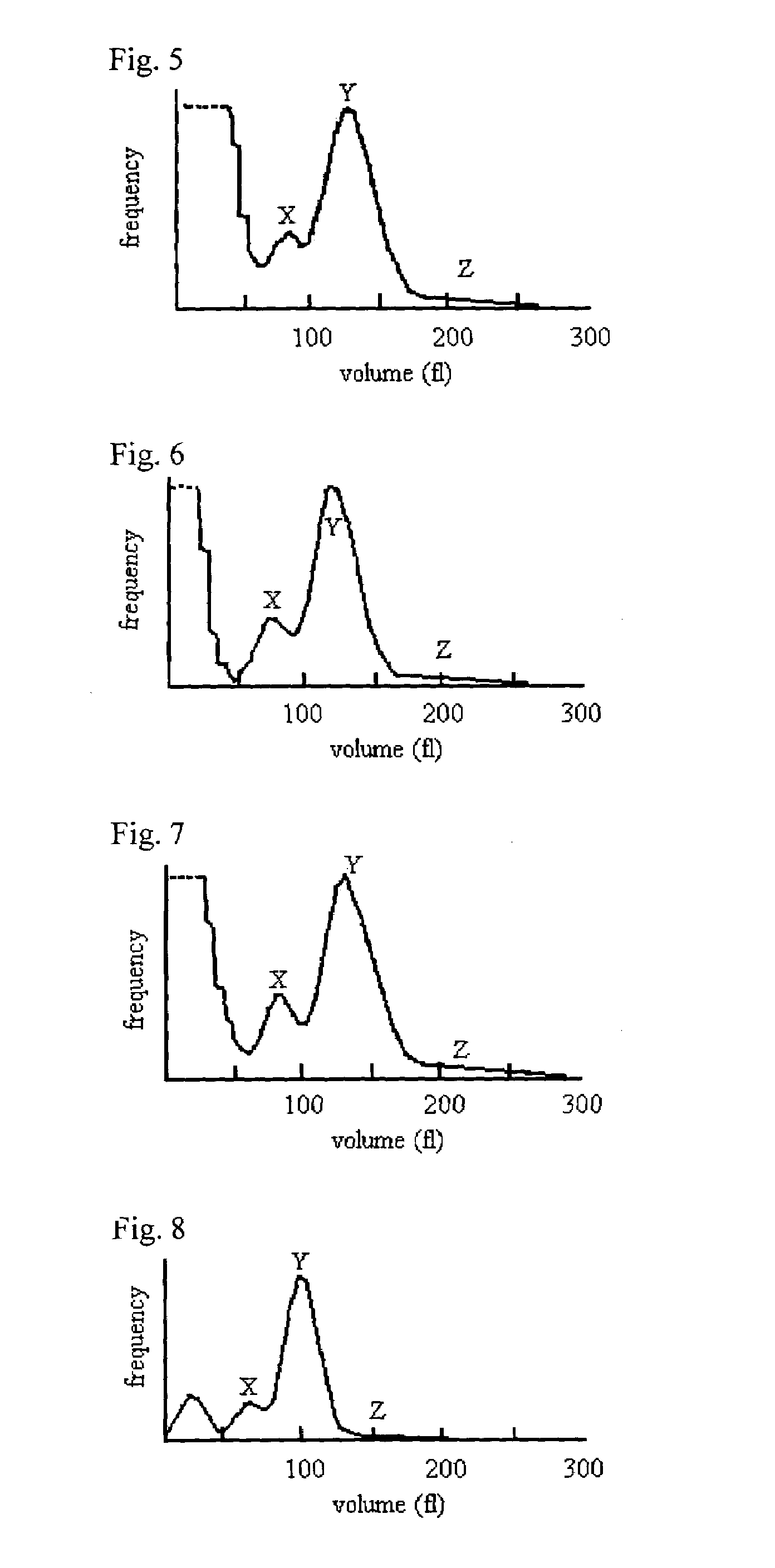Method and reagent for classifying leukocytes in animal blood
a technology of leukocytes and reagents, applied in chemical methods analysis, instruments, investigating phase/state change, etc., can solve the problems of not being able to classify eosinophils into a sub-group, and the need for disposal of waste-fluid
- Summary
- Abstract
- Description
- Claims
- Application Information
AI Technical Summary
Benefits of technology
Problems solved by technology
Method used
Image
Examples
example 1
[0048]On the basis of a description of U.S. Pat. No. 5,968,832, the present inventors prepared a lysing reagent (lysing reagent 1) capable of classifying human leukocytes into 3 sub-groups, that is, lymphocytes, neutrophils and other leukocytes.
The composition of the lysing reagent 1 is as follows:
[0049]
Lysing reagent 1Lauryl trimethyl ammonium chloride7.9g / L (30 mM)Stearyl trimethyl ammonium chloride0.84g / L (2.4 mM)Sodium chloride4.13gSuccinic acid3.0gEDTA-2K2.5gSodium hydroxide1.55gPurified water1LpH 5.3
[0050]Using the lysing reagent 1, human, dog and cat blood samples were measured with an automatic hemocytometer pocH-100iV (Sysmex Corporation). In this hemocytometer, a blood sample is diluted with a diluent poch-pack D (Sysmex Corporation) to prepare a sample diluted 500-fold. Then, one volume of the lysing reagent 1 is added to two volumes of the diluted sample to prepare a measurement sample. Thirteen seconds after the lysing reagent is added, leukocytes are counted for 6 seco...
example 2
[0076]Lysing reagents 2 to 6 having the same composition as in the lysing reagent 1 except for the concentrations and combination of the quaternary ammonium salts were prepared, and each lysing reagent was used to measure dog and cat blood samples. The quaternary ammonium salts used are as follows:
[0077]Alkyl trimethyl ammonium salts[0078]Decane trimethyl ammonium bromide (DTAB): number of carbon atoms in the alkyl group, 10[0079]Lauryl trimethyl ammonium chloride (LTAC): number of carbon atoms in the alkyl group, 12[0080]Myristyl trimethyl ammonium bromide (MTAB): number of carbon atoms in the alkyl group, 14[0081]Stearyl trimethyl ammonium chloride (STAC): number of carbon atoms in the alkyl group, 18
[0082]Alkyl dimethyl ethyl ammonium salt[0083]Cetyl dimethyl ethyl ammonium bromide (CDMEB): number of carbon atoms in the alkyl group, 16
[0084]The concentrations and combination of the quaternary ammonium salts in the lysing reagents 2 to 6 are as shown in Table 1.
[0085]
TABLE 1Alkyl ...
example 3
[0093]Lysing reagent 7 having the following composition containing a nonionic surfactant was used to measure dog and cat blood samples. The nonionic surfactant contained in the lysing reagent 7 is Emulsit 9 (polyoxyethylene nonyl phenyl ether) that is a nonionic surfactant having an HLB of 17 to 20.
[0094]
Lysing reagent 7Cation-AB2.16g(Containing 23% stearyl trimethylammonium chloride, manufactured byNippon Oil & Fats Co., Ltd.)Lauryl trimethyl ammonium chloride2.39gCetyl dimethyl ethyl ammonium bromide0.2gMyristyl trimethyl ammonium bromide0.2gEmulsit 91.0g(Polyoxyethylene nonyl phenyl ether,manufactured by Dai-ichi Kogyo SeiyakuCo., Ltd.)Sodium chloride4.13gSuccinic acid3.0gEDTA-2K.2H2O2.5gSodium hydroxide1.55gSodium nitrite0.69gPurified water1LpH 5.3, osmotic pressure of 280 mmol / kg
[0095]The lysing reagent 7 contains, as quaternary ammonium salts, 1.43 mM stearyl trimethyl ammonium chloride, 9 mM lauryl trimethyl ammonium chloride, 0.53 mM cetyl dimethyl ethyl ammonium bromide and...
PUM
| Property | Measurement | Unit |
|---|---|---|
| carbon number | aaaaa | aaaaa |
| concentration | aaaaa | aaaaa |
| carbon number | aaaaa | aaaaa |
Abstract
Description
Claims
Application Information
 Login to View More
Login to View More - R&D
- Intellectual Property
- Life Sciences
- Materials
- Tech Scout
- Unparalleled Data Quality
- Higher Quality Content
- 60% Fewer Hallucinations
Browse by: Latest US Patents, China's latest patents, Technical Efficacy Thesaurus, Application Domain, Technology Topic, Popular Technical Reports.
© 2025 PatSnap. All rights reserved.Legal|Privacy policy|Modern Slavery Act Transparency Statement|Sitemap|About US| Contact US: help@patsnap.com



